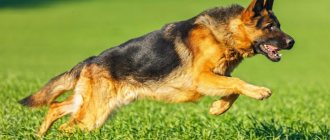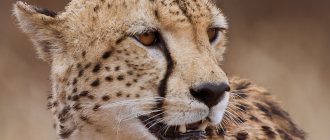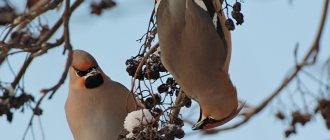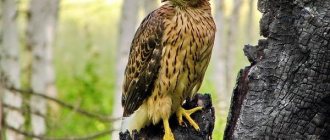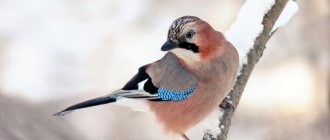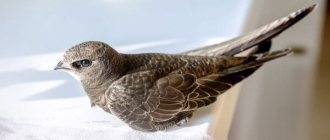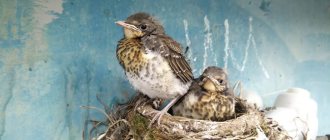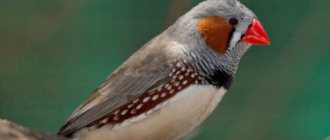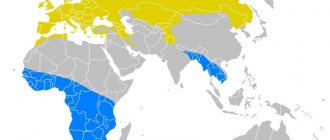Regarding speed, all birds are divided into 2 categories, the first category reaches maximum speed during normal flight, while the second develop speed during a dive. Kinetic energy depends on many indicators, such as body mass, the height of the flight itself, and the acceleration of gravity.
When diving, birds do not fly; they fall freely. But during horizontal flight, the speed changes depending on the acceleration and body weight. Let's look at the five fastest birds on our planet.
Sapsan - record holder for high-speed flights
A high-speed electric train traveling from Moscow to St. Petersburg is named in honor of the peregrine falcon. Its maximum design speed is slightly inferior to the swiftness of the bird and is 300 km/h.
The peregrine falcon is the fastest bird, capable of diving at a speed of 389 km/h. The speed of horizontal flight is also quite high and can reach 110 km/h, and the average horizontal speed varies from 60 to 90 km/h. The peregrine falcon is a bird of prey and belongs to the falcon family. Currently, there are about 17 subspecies, which have slight differences in plumage color and size.
The body length of an adult varies from 34 to 50 cm, and the wingspan from 80 to 120 cm. Females are usually much larger, weighing approximately 900-1500 g, males weigh less - from 440 to 750 g. Peregrine falcons have a short, curved beak, a wide chest, pointed wings, strong paws with sharp claws and a rather long tail. The back, wings and rump are dark gray, and the belly is light with dark spots. The top of the head, the tips of the wings and the bottom of the tail are black.
Most often, peregrine falcons hunt various birds - starlings, sparrows, pigeons, ducks; they can also attack small mammals and reptiles, and sometimes catch insects. The range is quite wide, they live on all continents, with the exception of Antarctica, but the number of peregrine falcons is small. The species is listed in the Red Book of Russia and is protected; trade in these birds is prohibited.
Female and male: main differences
Female and male falcons
Most species of falcons lack sexual dimorphism. Meanwhile, females are distinguished from males by size: “girls” are always larger than “boys.” Males of some species are more variegated in color, with the area around the eyes having a bright tint.
Female
Female falcons are one and a half times larger than males. The weight of some birds reaches 1-1.5 kilograms. Females have a color similar to their partners, however, during breeding, the color of the feather fades somewhat. A greater difference between females and males is observed in the falcon species. The female falcon is colored in brown and fawn tones, with a black transverse stripe on its back. There are whitish streaks on the wings and tail.
Male
Falcon on the hunt
The body weight of a male falcon ranges from 150-500 grams. Males, like females, have brown, fawn, and ocher colors in their plumage. In male falcons, compared to females, the upper part of the body is dark gray with a blue “patina”, the lower abdomen is dirty red.
Saker falcon is the national bird of different countries
Saker falcons form permanent pairs that settle exclusively in the nests of other birds. A couple can occupy the same “housing” for several years. Sometimes one pair of saker falcons may have several nests located not far from one another.
The saker falcon is also capable of developing very high speeds in the air, and it flies quickly in both the vertical and horizontal directions. During a diving flight, the bird can reach a speed of 320 km/h, and during a horizontal flight – about 150 km/h. The saker falcon is quite large in size - the wingspan of the largest individuals reaches 126 cm, body length - 57 cm, and weight up to 1.3 kg. Females and males are similar in appearance, with dark plumage, a dense build and narrow, pointed wings, but females tend to be about 1/3 larger.
The saker falcon is a rare bird from the falcon family. It is found in the southern part of Siberia, Transbaikalia and Cisbaikalia, in Kazakhstan, as well as in Eastern and Central Europe. Favorite habitats are spacious grasslands with sparse trees or rocky terrain. Saker falcons are skilled hunters. They usually catch a variety of small mammals, medium-sized birds and sometimes lizards. Moreover, they often attack their prey not from above, like the peregrine falcon, but by pursuing it in rapid horizontal flight.
In Hungary, the saker falcon has long been the national bird. In 2012, it received the status of the national bird of Mongolia. For several thousand years, this bird has been used in falconry. It was highly valued due to its ability to reach high speeds in both vertical and horizontal flight. To increase the number of Saker Falcons, they are bred in special nurseries.
The fastest birds in the world - flight speed and records
Birds are a special type of warm-blooded animal, characterized by a body covered with feathers and, as a rule, forelimbs in the form of wings. This feature allows birds to move in various environments: fly, run on the ground, swim, while developing speeds that are beyond the capabilities of many other species of animals.
The fastest of waterfowl, the penguin, swims slowly on the surface of the water, like a duck. But when diving, it reaches a speed of 36 km/h, flapping its flipper-like wings and lowering and emerging from the water every minute to breathe air. The world champion swimmer among humans swims 6 times slower than a penguin, and the fastest warships in the world are capable of reaching a speed of 47 knots (87 km/h), outpacing penguins by only 2.4 times.
Top fastest birds by flight speed - movements:
- Falcon Sapsan - 322 km/hour
- Berkut - 300 km/hour
- Needle-tailed swift - 170 km/h
- Frigates 153 km/h
- Spur goose 142 km/h
- Average Krokhal 129 km/h
- Ostrich - 70 km/h, record 92 km/h details
- The penguin swims like a duck, and under water 36 km/h
In those areas of the Earth where high speed movement across it is a vital necessity (Africa, Australia, East Asia), ostriches live up to 2.5 m tall and weigh up to 0.15 tons, whose powerful limbs allow them to move in steps of up to 5 m with speed 70 km/h. The famous Kenyan Noah Ngeni, who ran 1000 m in 2 minutes. 11.96 seconds, in a competition with an ostrich I would be 1 minute behind him. 20 sec.
Birds set the most impressive records during air flights. In this type of movement, the champion in diving flight is the peregrine falcon, which lives on all continents of the Earth except Antarctica. Not every car can compare with a peregrine falcon, which reaches a speed of 90 m/sec., i.e. 322 km/h. Among living creatures, only the black swift can compete with it, flying 2 times slower in a diving flight, but outpacing the falcon in horizontal flight.
The golden
eagle , which lives in the mountains and forests of 4 continents (Asia, Europe, North America and Europe), is considered the most dangerous of the hawk family. The golden eagle hunts not only birds, hares and rodents, but also cattle (calves, roe deer, deer and sheep), despite the fact that its length does not exceed 0.95 m and weight 6.5 kg. The wingspan of the golden eagle reaches 2.2 m, the diving flight speed is 300 km/h, which is comparable to the fastest falcon, the peregrine falcon. Since ancient times, the golden eagle, as an excellent hunter, has been respected by humans. The needle-tailed swift lives in the hollows of forest trees in Asia, including the southern part of Siberia and the Far East. Its diet, despite its small size and weight of its own body (length up to 0.2 m, weight up to 0.14 kg), consists of insects. Therefore, the needle-tailed swift does not require a high speed of diving flight; for it, the speed of horizontal flight is more important, which is the highest speed of all birds in the world - 170 km/h with a wingspan of up to 0.55 m. All 5 species of the frigate live in the tropics and subtropics in areas with bodies of water, over which they spend a long time in soaring flight, looking out for their prey. The main objects of frigate hunting are flying fish and fish caught by other aquatic birds, which frigates take from them. This method of hunting is available to frigates due to their physical characteristics: a large body up to 1.14 m long, a weight of up to 1.6 kg, a narrow wingspan of up to 2.44 m and a high flight speed of 153 km/h, which in absolute terms ranks 4th. e place in the world, and second in horizontal flight speed. The large-sized spur goose, up to 1.15 m long and weighing up to 10 kg, is common on the banks of reservoirs south of the Sahara Desert. Its diet is quite varied and includes plant foods (coastal and aquatic), insects (termites, beetles, caterpillars) and small fish. To meet the needs of a large bird, a lot of such food is required; it has to be collected from a vast territory, for the flight of which the spur goose is equipped with wings with a span of up to 2 m and develops a flight speed of 142 km/h, slightly behind the frigate in this indicator. The waterfowl medium merganser , which is small in size (length up to 0.62 m, weight up to 1.4 kg), lives on the coastal shores of Northern Asia, Europe and America covered with thick grass. The average merganser feeds on aquatic plants, insects, worms, crustaceans, amphibians, but its main food is small fish, to catch which it is able to dive for 0.5 minutes to a depth of 30 m. Catching small food also requires the ability to move quickly, with a swing wings up to 0.86 m, the average merganser develops a flight speed of 129 km/h, closing the top five fastest-flying birds in the world according to this indicator.
The high diving speed of the Peregrine falcon has developed in connection with its hunting technique: gliding high in the sky to detect the victim, diving towards it at maximum speed to deliver a powerful blow with its limbs pressed to the body. With such a blow, the falcon is able to cut off the head of a victim, for example, a duck or a pigeon, despite the fact that its size is comparable to that of a crow.
Despite its long life expectancy, the ability to reproduce throughout its life, and its easy adaptability to any living environment from the hot tropics to the Arctic cold, the peregrine falcon, as a result of the use of pesticides and other air pollutants, has become a rare bird listed in the Red Book. In the eastern states of the United States and many European countries, peregrine falcons have disappeared; in the western states of the United States, their population has decreased by 90%. Environmental programs implemented since the 1970s have allowed the falcon population to gradually recover. In the Russian Federation it has reached 3 thousand pairs, a nursery has been created in the Galichya Gora Nature Reserve. In the United States, peregrine falcons breed in nests on skyscrapers and cathedrals. In Canada and Germany, enclosures for raising young animals have been built. The Royal Society for the Protection of Peregrine Falcons and Other Birds operates in England.
Among falcons, the peregrine falcon is a large bird with a length of up to 0.5 m, a wingspan of up to 1.2 m, a female weighing up to 1.5 kg, a male is 2 times less. An active predator, the peregrine falcon has hard muscles, a broad chest, sharp talons, large eyes and a sickle-shaped beak with serrations for biting the neck of its prey.
The falcon family group with the peregrine falcon includes the gyrfalcon, saker falcon, laggar, Mexican and Mediterranean falcons; the evolutionary divergence between them began millions of years ago. When a peregrine falcon is crossed in enclosures with other representatives of this group, the offspring acquires the qualities of both parents. For example, a descendant of a peregrine falcon and a Mediterranean falcon acquires the endurance of a Mediterranean falcon and the hunting instinct of a peregrine falcon.
The scientific name of the peregrine falcon in European languages comes from the Latin words falco (crescent-shaped) and peregrinus (wandering) - Falco peregrinus or peregrine falcon (English), . faucon pèlerin (French), falco pellegrino (Italian), wanderfalke (German), pilgrimsfalk (Swedish). The Russian name "peregrine falcon" presumably comes from Kalmyk (real falcon).
The peregrine falcon's habitats are most often inaccessible to humans (rocks on the banks of reservoirs and mountains, cliffs of mountain rivers, moss swamps), less often on the roofs of city churches and multi-story buildings. Peregrine falcons often remain for the winter in or near their permanent habitat, but in the Arctic climate they are able to fly very long distances. Peregrine falcons carefully guard their territory, displacing even flying eagles and humans. Nests are located near bodies of water, in crevices of rocks, on hummocks of swamps, in hollows of trees, sometimes they occupy nests in trees made by crows, kites and other birds of prey, in cities on bell towers, chimneys, and the eaves of high-rise buildings. The female lays eggs in late April or early May, and both the female and the male incubate the eggs for more than a month. After the birth of the chicks, the male obtains food, and the female warms the offspring. At 1.5 months of age, the chicks begin to fly.
The peregrine falcon's diet includes birds, small mammals, insects and amphibians (sparrows, pigeons, ducks, starlings, bats, hares, squirrels, gophers). The peregrine falcon lifts the prey it has caught high to the nesting site.
Since ancient times, people in Mongolia, China, and the Middle East have used peregrine falcons for falconry. The Egyptian sun god was depicted as a disk with falcon wings or a man with a nightingale's head. In Europe, the falcon began to be used for hunting only in the 3rd century. elite of society. From the Middle Ages to the 19th century, the coronation of English kings was accompanied by the gift of a pair of peregrine falcons. In Russia, falconry was made popular by the nomadic Khazars. Later, an image of a peregrine falcon appeared in the center of the coat of arms of the Bashkir city of Kumertau and the Russian cities of Sokol and Suzdal. The symbolism of the peregrine falcon is widely used in many countries: in the name of a motorcycle, a fighter plane and a spacecraft in Japan, the name of a Siemens high-speed electric train, and an image on a commemorative coin of the US state of Idaho.
The peregrine falcon, as the absolute champion in diving flight speed, has attracted human attention throughout its history.
Golden eagle - the largest and fastest eagle
Golden eagles have excellent eyesight. They can spot prey at a distance of 4 km. In addition, they see everything in color, which is very rare in the animal world.
Another bird of prey that can reach very high speeds is the golden eagle. During a diving flight, its speed can be 320 km/h, and during horizontal flight – up to 190 km/h. The golden eagle is the largest of all eagles, the wingspan of the largest individuals reaches 234 cm, and the body length is 102 cm. Females usually exceed males in size by about 30%. The maximum weight of a female is 6.7 kg, and a male is 4.6 kg.
The golden eagle is dark brown in color, and the feathers on the back of the head and neck are golden, which is why in English-speaking countries it is often called the “golden eagle”. These birds have very acute vision; their eyes are designed in such a way that the lens is able to quickly focus on a moving object and not let it out of sight for a long time. In addition, the golden eagle's neck is very mobile and can rotate 270 degrees, significantly increasing the degree of visibility. These features help when hunting fast running animals.
Golden eagles usually hunt hares, various rodents, small birds, and sometimes larger animals - foxes, wolves, baby sheep, deer, roe deer. In search of prey, they soar high in the sky, and, having spotted game, they make a quick dive flight at high speed.
Golden eagles live in the Northern Hemisphere of the Earth, preferring mountainous terrain, as well as spacious plains. Residents of Asia have long tamed them to hunt various wild animals. Young golden eagles quickly get used to their owner and then do not try to fly away.
Spreading
Falcon on a stone
Falcons are found all over the world. Its habitat covers the American continent, Eurasia, Australia and Africa. These birds are not found only in Antarctica.
Falcon's gaze
Several species of falcons live in Russia - gyrfalcons, peregrine falcons, Amur falcon, etc. A large population of birds nests on the Chukotka Peninsula, on the coast of the Bering Sea, in Kamchatka.
Habitats
Falcon in the swamp
Birds of prey prefer to settle in open areas. They hunt in meadows, savannas, and wide forest clearings. Nests are made on tree branches and in rocky cavities. They always live next to a body of water. Some species of falcons, such as the gyrfalcon, nest near human habitation.
Falcon: migratory bird or not
Falcon flies in the sky
Most species lead a sedentary lifestyle. Only young birds fly south. Sexually mature birds migrate to the south of their habitat for the winter, not moving more than 500 kilometers from their previous place. Falcons are inquisitive by nature, so they spend a lot of time exploring the world. During educational walks, falcons can fly from home to a distance of a thousand kilometers. Many falcons spend their entire lives endlessly “moving.”
Gyrfalcon - the largest falcon
Gyrfalcons rise into the air vertically, and not in a spiral, like many other birds.
The gyrfalcon is the largest representative of the falcon family. Its body length can be 60 cm, and its wingspan can be 135 cm. During a diving flight, this bird can reach a speed of 209 km/h, and in a horizontal flight – 145 km/h. Gyrfalcons have long been used in falconry, which was popular in England, France, Iceland, and Russia. Now they are bred in special nurseries. The species is listed in the Red Book as its numbers are declining.
The gyrfalcon lives in the cold arctic and subarctic zones in Europe, North America and Asia. Preys on medium-sized birds and small mammals. Every day he needs to eat about 200 g of food. Usually it catches its prey in flight, swooping down on it from above and grabbing it with its paws with sharp claws.
Birds mate for life. As a rule, they do not build nests, but occupy old ones that other birds have built, subsequently using them for many years. The female usually lays 3-4 eggs. The male helps feed the chicks until they learn to hunt themselves.
Nutrition
Falcon eats its prey
Falcons feed on medium-sized birds. The diet includes pigeons, starlings, and sparrows. Forest falcons hunt black grouse, partridges, owls, and owls. Birds living near ponds feast on ducks, razorbills, and ducks. In rare cases, falcons hunt small mammals - lemmings, hares, squirrels, gophers.
The needle-tailed swift is a bird that does not sit on the ground
The shaft of each tail feather in these birds protrudes beyond the edge of the tail in the form of a needle, hence the name
The needle-tailed swift is also famous for its amazing speed. It is known that it can perform horizontal flights at a speed of 170 km/h. The swift's body length reaches approximately 20 cm, its wingspan is about 55 cm, and its weight ranges from 100 to 175 g. The plumage is grayish-brown, only the throat and feathers at the base of the tail are painted white. The tail of this species is not pointed, as one might think from the name. It seems to be cut evenly, but the shaft of each tail feather protrudes 3-5 mm outward in the form of a needle. Because of this feature, the bird got its name.
Swifts love to fly so much that they almost never sit still, except when hatching eggs. They spend most of their lives in the air, where they get food, rest and even sleep. Swifts feed on various small insects, which they deftly grab in flight. They often settle near various bodies of water, and also live in forests growing next to meadows or other open places.
Needle-tailed swifts are migratory birds. They nest in the southern part of Siberia and Central Asia, and fly to India, Australia and Southeast Asia for the winter. They arrive from warm countries in late spring. Nests are made in tree hollows, where they lay from 3 to 7 white eggs, about 3 cm long. They fly south quite early - in early autumn.
Spine-tailed swifts were first described by the English ornithologist John Latham in 1801.
How long does it take for birds to digest food?
The smaller the bird, the more food per gram of body weight it requires. As the size of an animal decreases, its mass decreases faster than the body surface area through which heat loss occurs. Therefore, small animals lose more heat than large animals. Small birds eat an amount of food per day equal to 20–30% of their own weight, large birds – 2–5%.
A tit can eat as many insects as it weighs in a day, and a tiny hummingbird can drink an amount of nectar that is 4-6 times its own weight.
Repeating the stages of food breakdown and the features of the respiratory system of birds, we fill out diagram No. 1 step by step.
The intense motor activity of birds requires large amounts of energy. In this regard, their digestive system has a number of features aimed at efficiently processing food. The beak serves as the organ for capturing and holding food. The esophagus is long, in most birds it has a pocket-like extension - a crop, where food is softened under the influence of crop fluid.
The glandular stomach has glands in its wall that secrete gastric juice.
The muscular stomach is equipped with strong muscles and is lined on the inside with a strong cuticle. Mechanical grinding of food occurs in it. The digestive glands (liver, pancreas) actively secrete digestive enzymes into the intestinal cavity. The broken down nutrients are absorbed into the blood and distributed to all cells of the bird's body.
Small owls (little owls) digest a mouse in 4 hours, a gray shrike in 3 hours. Juicy berries pass through the intestines of passerines in 8–10 minutes. Insectivorous birds fill their stomachs 5–6 times a day, granivorous birds – three times.
However, the absorption of food and the entry of nutrients into the blood is not the release of energy. Nutrients need to be “burned” in tissue cells. What system is involved in this? ( Light, air bags.
)
– Muscles must be well supplied with oxygen. However, birds cannot provide the required amount of oxygen due to a large amount of blood. Why? ( Increasing the amount of blood would increase the bird's mass and make it more difficult to fly.
)
Intense supply of oxygen to tissue cells in birds occurs due to “double breathing”: oxygen-rich air passes through the lungs both when inhaling and exhaling, and in the same direction. This is ensured by a system of air sacs penetrating the bird’s body.
In order for blood to move faster, increased blood pressure is necessary. Indeed, birds are hypertensive. In order to create high blood pressure, the heart of birds must contract with great force and high frequency (Table 5).
Table 5. Heart mass and heart rate
| Bird | Relative heart weight, % | Contraction frequency per minute |
| Stork House Sparrow Raven Pigeon Goose Hummingbird Ostrich Swift black | 8,6 15,2 9,0 14,0 8,0 23,9 9,8 16,5 | 270 745–850 300–352 150–250 80 ? 60–70 700 |
As a result of the oxidation (combustion) of nutrients, energy is generated. What is it spent on? (We finish filling out diagram No. 1).
Conclusion.
An active oxidative process helps maintain a constant body temperature.
High body temperature ensures a high level of metabolism, rapid contraction of the heart muscle and skeletal muscles, which is necessary for flight. High body temperature allows birds to shorten the development period of the embryo in the incubated egg. After all, incubation is an important and dangerous period in the life of birds.
But constant body temperature has its drawbacks. Which? We fill out diagram No. 2.
So, maintaining a constantly high body temperature is beneficial for the body. But for this you need to consume a lot of food, which you need to get somewhere. Birds had to develop various adaptations and behavioral traits that allowed them to obtain sufficient food. Here are some examples.
Next, students make reports on the topic “How different birds get their food” (their preparation could be homework for this lesson).
Pelican fishermen
Pelicans sometimes fish together. They find a shallow bay, cordon it off in a semicircle and begin to flap the water with their wings and beaks, gradually narrowing the arc and approaching the shore. And only after driving the fish to the shore do they begin fishing.
Owl hunting
Owls are known to hunt at night. The eyes of these birds are huge, with greatly dilated pupils. Through such a pupil, even in poor lighting conditions, enough light enters. However, it is impossible to see prey - various small rodents, mice and voles - from afar in the dark. Therefore, the owl flies low above the ground and looks not to the sides, but straight down. But if you fly low, the rustle of the wings will scare away the prey! Therefore, the owl has soft and loose plumage, which makes its flight completely silent. However, the main means of orientation for night owls is not vision, but hearing. With its help, the owl learns about the presence of rodents by squeaking and rustling and accurately determines the location of the prey.
Armed with a stone
In Africa, in the Serengeti nature reserve, biologists observed how vultures obtained food for themselves. This time the food was ostrich eggs. To get to the treat, the bird took a stone with its beak and threw it forcefully onto the egg. The strong shell, which could withstand the blows of the beak of even such large birds as vultures, cracked from the stone, and the egg could be enjoyed.
True, the vulture was immediately pushed away from the feast by the vultures, and he began to work on a new egg. This interesting behavior was later repeatedly noted in the experiment. They threw eggs to the vultures and waited to see what would happen. Noticing a delicacy, the bird immediately picked up a suitable stone, sometimes weighing up to 300 g. The vulture dragged it in its beak for tens of meters and threw it on the egg until it cracked.
One day, a vulture was given fake chicken eggs. He took one of them and began to throw it on the ground. Then he took the egg to a large rock and threw it against it! When this did not bring the desired result, the vulture began to desperately beat one egg against another.
Numerous observations have shown that birds tried to split any egg-shaped object with stones, even if it was huge in size or painted in unusual colors - green or red. But they didn’t pay any attention to the white cube. Scientists have also found that young vultures do not know how to break eggs and learn this from older birds.
Osprey fisherman
The osprey bird is an excellent fisherman. Seeing a fish, it quickly rushes into the water and plunges its long sharp claws into the body of the victim. And no matter how hard the fish tries to escape from the claws of the predator, it almost never succeeds. Some observers note that the bird holds the caught fish with its head in the direction of flight. Perhaps this is an accident, but it is more likely that the osprey tries to catch fish in such a way that it will be easier to carry later. Indeed, in this case, air resistance is less.
Conclusion based on student reports
– the progressive development of the brain and leading sensory organs (vision, hearing) is associated with intense metabolism, high mobility and complex relationships with environmental conditions.
Now explain why birds have become widespread in all climatic zones. What are the reasons for bird migration? ( Warm-blooded allows birds not to be afraid of frost and remain active even at very low ambient temperatures. However, the lack of food in winter forces them to migrate to better feeding places.
)
The black swift is a bird that flies almost non-stop
Swifts have very small legs, so they almost never land on the ground, as it is difficult for them to take off from a horizontal surface.
Another fast bird is the black swift. During a diving flight, its speed can be 166 km/h, and in a horizontal flight – about 111 km/h. Swifts surprise not only with their speed, but also with their ability to fly for a very long time. Scientists claim that they can be in the air for most of the year, excluding 2 months when they hatch chicks. During its life, a swift can fly millions of kilometers.
The black swift belongs to the swift family. Its body length is approximately 18 cm, and its wingspan is about 44 cm. The color is dark brown with a slight greenish sheen, and there is a white spot on the neck. The beak is small, black, the tail is fork-shaped, the paws are very small, light brown. In summer, the plumage may fade in the sun and look lighter than usual.
Distributed in Europe and Asia, wintering in Africa and southern India. They often settle in cities. Immediately after returning from wintering, they begin to build nests, which are arranged under the roofs of houses, in cracks in walls and in hollows of trees. The clutch usually consists of 2-3 small eggs. Swifts form permanent pairs and hatch chicks in turns. The chicks are in the nest under the care of their parents from 38 to 56 days, and when they leave it, they are able to fly well and get their own food.
These birds feed on various small insects, which they catch in flight. During nesting, in order not to leave the clutch, they can live without food for several days, during this period their body temperature decreases and a state of torpor sets in.
Lifestyle
Falcon cries
Falcons are solitary birds. They do not gather in flocks even during migrations. Birds prefer to stay in pairs and build nests far from relatives (at a distance of 2-3 kilometers).
These birds can deftly maneuver, reach incredible speeds in flight, and deal with their prey in the air with lightning speed. At the same time, on the ground the bird does not behave so quickly and confidently. The falcon's steps on a flat surface are uncertain and clumsy. In this state, the falcon often becomes a victim of foxes, weasels and martens.
Falcon hunts hare
Falcon is a master of the hunt. Chasing prey, the bird can cover up to three hundred kilometers in an hour. Birds attack victims in the air. Sometimes, when hunting an animal, a falcon deliberately scares it so that it runs: catching “lunch” at high speed is an exciting activity for a falcon. Well-fed falcons are busy with active games in the air - they arrange comic fights with their brothers, plan for hours, and perform exciting pirouettes.
The lifespan of falcons is 15-16 years. However, in the wild, not all birds survive to the age limit. In captivity, birds can live 18-20 years.
Falcon hunting
Falcon hunts in winter.
Falcons hunt in the air. Birds spend hours gliding in the sky in search of prey. Having noticed the prey, the bird rises high above it (to gain speed), and then quickly rushes vertically down towards the prey. Having reached the victim, it strikes it with force with its muscular paws. The kick can be so strong that the game dies instantly. Having killed an animal, the falcon brings it to a quiet place, where it first plucks and butchers it, and only then eats it.
Two falcons cannot divide their prey
Every day one falcon eats 200-250 grams of food. In a hungry year, the predator eats the whole prey, but if the bird does not lack food, it can only eat large muscles.
Reproduction
Photo of a
falcon Falcons are monogamous birds. Different species have their own nesting periods: southern falcons mate in the summer - from July to September; birds living in the north breed from February to March. Mating rituals are similar among all bird species. The male presents the female he likes with a gift - a twig or leaf. Ritual dances of males last 7-10 days. At this time, birds circle in the sky and constantly sing loud, ringing songs.
Falcon family
Mating of partners takes place in the sky. Sometimes you can see how birds, clinging to each other with their claws, rise high into the sky, and then suddenly rush to the ground. The diving flight lasts 5-10 seconds, then the falcons begin to smoothly rise upward again.
Chicks and falcon in the nest
Birds choose secluded, quiet places to nest. Birds nest on the tops of trees, under the eaves of buildings or in rock gorges. Some species of falcons prefer not to waste time on arranging their homes, and occupy the abandoned nests of other birds. The female lays 2-4 large, red-colored eggs at a time. The larger the bird, the more eggs it can lay. Both parents are involved in breeding offspring. While the female sits on the eggs, the male feeds. Then the parents change. The incubation period is 29-32 days.
Falcon chicks
Photo of a falcon chick.
Falcon chicks are born sighted and well-furred. The fluff is dirty white. For the first three weeks of life, parents warm and feed the chicks and protect them from birds of prey and animals. The diet of chicks includes insects, eggs of other birds, and lizards.
A falcon chick in a man's hand
After a month, the falcon chick already knows how to get its own food and defend itself from enemies. During this period, the falcon leaves the parent's nest. He does this because the parents stop seeing him as their baby and begin to treat him as a competitor for food. If the chick does not leave the nesting site in time, the adults may peck at it.
Two falcon chicks
In the first year of life, grown falcons fly to warm countries for the winter. By the age of two they reach sexual maturity - from then on, most of them stop migrating.
Hobby - a fast and dexterous hunter
The flight is fast and maneuverable, frequent flapping of the wings alternates with gliding, the cap does not hover.
Hobby is another representative of the falcon family that is capable of high speed. It is believed that when diving, it flies at a speed of about 159 km/h and can even sometimes overtake a swift, as it often hunts for it. The hobby inhabits Eurasia and North Africa, settling in light, sparse forests and forest-steppes with open spaces.
The physique is quite elegant, body length varies from 28 to 36 cm, wingspan - from 69 to 84 cm, and weight from 130 to 340 g. The plumage on the back and upper part of the head is dark gray, on the chest and belly - yellowish-white with dark spots, and red on the legs. The cheeks and neck are painted white, and there are black “whiskers” near the beak.
The hobby hunts small birds such as swifts and swallows, as well as bats and various insects. It makes nests in old nests built by crows or magpies. The female usually lays from 2 to 4 eggs and incubates the clutch for about 30 days, while the male brings her food all this time. When the chicks are born, the parents work together to care for them, bring them food and ward off predators who want to get into the nest.
The Hobby, like many other members of the falcon family, has long been tamed by humans and used in falconry. He was trained to catch quails, hoopoes, larks and other small birds.
Falcon and Hawk: Differences
Photo of a hawk
Falcon and hawk are two formidable predators that people far from ornithology often confuse. Externally, these birds are similar: both have a variegated brown-gray color, a hook-like beak, a knitted body, and dense plumage. However, the falcon and the hawk are birds belonging to different families. Each of these birds has a number of individual characteristics.
Differences:
- The falcon is part of the falcon family (Falco), the hawk is part of the accipitridae family (Accipitrinae).
- The falcon has sharp teeth on the top of its beak. The hawk's beak has a smooth contour.
- The falcon's eyes are black, while the hawk's iris is amber.
- The falcon's wings are long and pointed at the end. When opened, they create an obtuse angle. The hawk has rounded wings.
- The hawk beats its wings less frequently and can soar in the sky longer. Falcons have to flap their wings more often.
- The falcon hunts high in the sky, seeing its prey, it rushes towards it. A hawk soars close to the ground in search of food. Tracks prey from ambush.
- It is impossible to say for sure who is larger - a falcon or a hawk, since the proportions depend on the type of bird. For example, the gyrfalcon is larger than the sparrowhawk. And the peregrine falcon will be smaller than the goshawk.
Frigate – an extravagant flying postman
The magnificent frigatebird feeds mainly on fish and coleoids, which it catches in flight near the surface of the water. Sometimes it attacks other seabirds, causing them to drop their prey, and catches it while still in the air.
Frigates are famous not only for their high speed, but also for their ability to fly very long distances without stopping. The maximum flight speed is 153 km/h. Typically, frigates do not fly too fast, however, they can stay in the air for a very long time - from several weeks to 2 months. These birds feel very confident in the air; they easily soar at altitude, almost without flapping their wings.
There are 5 types of frigates. The largest of them is the magnificent frigate, its body length can reach 114 cm, its wingspan is 244 cm, and its weight is approximately 1.5 kg. Males have an unusual distinctive feature - a bright red throat sac that resembles a heart-shaped balloon. This bag appears during the mating season and serves to attract females.
The male builds the nest himself, makes special sounds that resemble the beating of a drum and waits for the female to choose him. Frigates are very caring parents. The female lays one egg in the nest, from which a chick emerges after about a month and a half. His parents care for him together, continuing to feed him even after he learns to fly.
On land, the frigate is quite clumsy, as it has very short legs. If he lands on the ground, he will not be able to fly, so he always lands on trees or large rocks. Interestingly, the inhabitants of Polynesia use these birds to transmit mail, like pigeons. Frigates are common in tropical and subtropical zones, often settling on oceanic islands remote from continents. They feed mainly on fish, which they snatch from the water in flight.
Peregrine falcon and man
Feathered predators such as the peregrine falcon are at the top of the food chain. It was proven that along the food chain (insects - small birds - raptors), the toxic components of DDT and other pesticides accumulated in the peregrine falcon’s body, affecting its reproductive system (the proportion of fertilized eggs fell) and calcium metabolism (the shells of the eggs became thinner and cracked). This caused a decline in the peregrine falcon population. Measures taken in the 60-70s of the last century to preserve birds of prey and the ban on the use of DDT had a positive effect on its population.
The peregrine falcon has long been domesticated for use as a hunting bird in falconry. Not all birds of the falcon family can be taught to hunt certain types of animals. For example, the kestrel got its name back when falcons were assessed only by whether they were suitable for hunting.
The Spur Goose is a poisonous African bird.
An unusual feature has been noticed in spurred geese: the spurs located on the wings contain a toxic substance that accumulates when the birds eat blister beetles.
The Spur Goose is a fairly large bird from the duck family, capable of reaching speeds of about 143 km/h. It got its name because of the special spurs located on the folds of the wings. This species is widespread on the African continent, south of the Sahara Desert. Favorite habitats are the banks of lakes and rivers.
The appearance of the spur goose is quite unusual - there is a bright pink spot around the long pink beak, and there are also unfeathered reddish areas on the neck on both sides. The coloring on the back and tail is black, on the head and neck it is brown, and on the chest, belly and sides it is white. The wings are quite long, black, and pointed in shape. There are swimming membranes on the legs that help to stay well on the water. Body length varies from 75 to 100 cm, and weight up to 5.9 kg.
INTERESTING FACTS, INFORMATION…
- During World War II, peregrine falcons were killed because they preyed on carrier pigeons that carried war messages.
- The male peregrine falcon is almost a third smaller than the female; in addition, he is distinguished by dark plumage on the top of his head, on the sides of which dark “whiskers” are clearly visible.
- This falcon has large eyes and keen vision. A peregrine falcon can recognize its prey even from a height of 300 meters.
- Peregrine falcons have long been used for hunting. Nowadays, falcon hunting is only a sport.
- The peregrine falcon is in danger of extinction. The population of these birds is steadily decreasing.
Grey-headed albatross - a lover of world travel
In 2004, the Grey-headed Albatross was included in the Guinness Book of Records as the bird with the fastest horizontal flight (127 km/h), which it maintained for 8 hours while returning to its nest on South Georgia Island during an Antarctic storm.
The grey-headed albatross is a member of the albatross family. It is capable of reaching a speed of 127 km/h in horizontal flight, and maintains it for at least 8 hours in a row. It lives on islands in the Southern Ocean, the largest colony is located on the island. South Georgia.
The body length of an adult grey-headed albatross is approximately 80 cm, the wingspan is about 2.2 m, and the weight varies from 2.8 to 4.4 kg. The plumage on the head and neck is gray, the back, chest, wings and tail are black, and the belly and undersides of the wings are white. The beak is black with bright yellow stripes on the sides and an orange spot in front. It is because of this feature that the albatross received its scientific name "chrysostoma", which means "golden mouth" in Latin.
Grey-headed albatrosses can not only fly beautifully, but are also capable of diving to depths of up to 7 m in pursuit of prey. They feed on squid, fish and various crustaceans. Birds spend a lot of time flying over the ocean. Young albatrosses, not burdened with caring for their offspring, can cover very long distances, making numerous flights around the globe.
The species is currently endangered, as grey-headed albatross numbers have declined by approximately 30% over the past 30 years. Some of the islands on which they nest have received nature reserve status and are protected.
What does it look like
— Advertising —
Falcon flaps its wings
The scientific name Falco comes from the word "falx", which means "sickle" - the sickle shape of the wings distinguishes falcons from other species of birds. Birds' wings are long and wide, thanks to which falcons are able to rise high into the sky and soar freely. The falcon feather is hard and glossy.
Photo of a falcon close up
The body of falcons is knocked down, rounded; The chest is wide and convex. The tail is long and shaped like a wedge. The head is large; the beak is small, strongly curved down. There are sharp teeth on the beak. The eyes are large, the skin around them is bare. The paws are thick, of medium length, four-toed.
— Advertising —
Evil look of a falcon
The color of the feather is individual for each individual species. Gray and brown tones predominate in most bird species. The plumage is not monochromatic - the main color is diluted with streaks and strokes of different sizes and colors. The irises of the eyes are usually black, the paws are bright yellow, sometimes feathered.
Features of character and lifestyle
Falcons are among the birds that can be domesticated and trained by humans to perform various tasks. These birds are distinguished by high intelligence, agile mind and quick wit. At the same time, they can safely live in captivity if the conditions of their detention are met.
Falcons are even capable of developing affection for humans. However, they have a proud and independent character: even when in captivity, they still remain freedom-loving birds. So, for example, if you do not allow them to show hunting instincts, limit their flight, birds may refuse to interact with humans, and then simply get sick.
By nature, birds are quite reserved and silent. They rarely use their voice, using it mainly to frighten prey during the hunt or scare away enemies. For birds of prey, the reproduction of melodic sounds is alien, since they simply do not need it. However, the call that the falcons make makes an impressive impression. It sounds from the sky and is a warlike, menacing exclamation, as unshakable and terrifying as the hunter himself.
Falcons sometimes stage a demonstration of their hunting capabilities in the sky, showing other birds their abilities and skills. All this resembles a real show in which birds make breathtaking pirouettes at high speed.
The Falcon can be called a master of flight. He uses his abilities not only during hunting, but also during the organization of numerous flights. Some members of the family spend their entire lives as nomads. At the same time, the nature of their movement is difficult to explain logically: sometimes they simply move from one place to another without any reason.
When hunting, birds usually use certain tactics. If they are hunting other birds, falcons usually try to get them in the air. Not wanting to fight on the ground, they usually startle the victim, causing it to fly into the air. In the air, birds of prey simply have no equal in strength and speed, and therefore catching prey becomes only a matter of time.
During the hunt, falcons, out of sport, can imitate unsuccessful lunges and throws that end in a miss. This is how they play with their prey.
